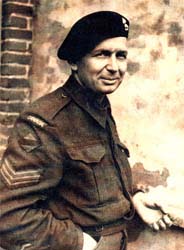Wall of Service
Column
1
Row
14
Walter Vandekamp was born on March 31, 1908. His name was Wounter v.d. Kamp, later changed to Walter Vandekamp. He arrived in Halifax in March of 1928 on board the M.S. Nieuw Amsterdam, the first ship to dock at Pier 21. He traveled to Vancouver and started working for Grauers Dairy farms until 1933-34. After working there he obtained a 320 acre homestead in the Caribou region plus or minus 80 miles E.N.E. of Lac la Hache, BC, built a log house and out buildings and started farming mainly beef cattle and sheep. He also had a 30-mile long trap line with several overnight huts built out of logs. The date of this naturalization is unknown.
In 1938, as there was no market for his products and it cost him more to ship his beef then he was paid for it, due to the depression, decided to sell his property and to go back to the Netherlands for a visit. After returning to Canada, he again worked for Grauers.
When Canada declared war on Germany in 1939 he joined the Seaforth Highlanders and was sent to Truro, Nova Scotia. Later he was sent overseas to Great Britain and was stationed at Aldershot and Truro, England. Then he was asked to join the Canadian Intelligence Corps and did some work behind enemy lines in Occupied Europe. He landed in Normandy on Juno Beach on the first day of the invasion. When they reached Belgium he was ordered to leave the 1st Canadian army and joined the 4th Canadian army and went north to liberate the Netherlands. They crossed the river Scheldt and landed on the island of Walcheren, where he incidentally met his future wife, Johanna Minderhout. He was wounded in the town of Flushing by a booby trap. From there he went to Germany until Germany capitulated on May 8, 1945. When Queen Wilhelmina visited the liberated part of the Netherlands in Feb. 45, he was her bodyguard and she made him an honourary member of the House of Orange which is quite and honour.
For the remainder of his service he was stationed in Apeldoorn in the Netherlands until he was repatriated on July 10, 1945 and sent back to Canada. He was discharged in Vancouver and went to Powell River where he lived until his demise in 1963. He left a wife, 2 sons and a daughter.
